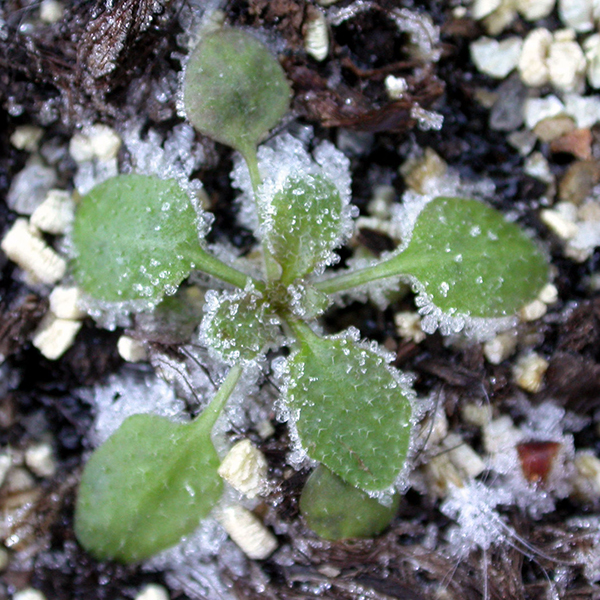“Junk” DNA helps plants to cope with cold stress

A vast amount of DNA contains no genetic information and was long thought to be junk. Recent research has shown that much of this “junk” DNA is in fact activated, but it was not known why. Researchers from Umeå Plant Science Centre have now shown that this activation of “junk”-DNA" plays a key role in promoting plant survival during stress.
The study from Peter Kindgren’s research group from Umeå Plant Science Centre and SLU was published recently in the journal The Plant Cell.
Our genetic code is stored in the DNA. When a gene is activated, the double-stranded DNA helix is unwound to make the two individual strands and the gene that is located on one of the two strands accessible. The gene, which contains the building description for a protein, is then rewritten into RNA, which is used as a template to synthesise the protein.
In humans, only one or two percent of the DNA contains genes and thus information for proteins. The rest was believed to be junk. However, new sequencing techniques have revealed that a lot of this “junk”-DNA is activated and rewritten into RNA-templates, even though it is not used for protein synthesis.
“We want to understand why so much of this “junk”-DNA is activated. This is a big question among scientists. It does not only occur in plants but also in other organisms and it is quite an investment”, explains Peter Kindgren, group leader at UPSC and researcher at SLU. “We think that there must be a common reason for this activation.”
Peter Kindgren and his research team focussed on “junk”-DNA that is located on the opposite DNA strand facing a gene. Such DNA segments are called “antisense” and are complementary to the opposite “sense” DNA segment (the gene), similarly like the two different strands of a zipper. The researchers have shown earlier that this type of antisense “junk”-DNA is often activated and rewritten to RNA in the model plant thale cress, but so far only a few examples have been further characterised in plants.
By looking through the known examples, Peter Kindgren and his group tried to identify a general function of this antisense DNA activation. They hypothesised that it might play a role in the regulation of the gene on the opposite sense DNA strand. The challenge was to devise a way to test this hypothesis. They wanted to inhibit the activation of the antisense DNA without affecting the activity of the gene on the opposite DNA strand.
“We used the gene scissor CRISPR-Cas9 to manipulate the region of the antisense strand where the rewriting of the DNA into RNA is initiated. Like this, the gene on the sense DNA strand could be rewritten normally into RNA and the corresponding protein could be synthesised, but less RNA was produced from the antisense strand,” says Shiv Meena, first author of the article. He was working as postdoc in Peter Kindgren’s group but has recently started to set up his independent research group in India at the National Institute of Plant Genome Research in New Delhi.
The researchers concentrated on genes that are switched on in thale cress during cold and that help the plant to adapt. When the activity of these genes was switched off, the plants were less tolerant to cold. The researchers observed a similar response in the plants that produced less antisense RNA. They concluded that the activation of the antisense DNA increases the gene activity on the opposite sense DNA strand and think that this might be a common mechanism in plants, especially important under stress.
“We are just beginning to understand why so much of this antisense “junk”-DNA is activated in plants, but we see great potential to use this knowledge to make plants grow better in more stressful environments,” says Peter Kindgren. “This story has been brewing in the lab since my postdoc. It is amazing that we finally were able to publish it. None of the people involved are actually working in my lab anymore. One moved to India, one to France, one to Spain, one to the US, and one to Uppsala. But we pulled it off!”
The article
Shiv Kumar Meena, Marti Quevedo, Sarah Muniz Nardeli, Clément Verez, Susheel Sagar Bhat, Vasiliki Zacharaki, Peter Kindgren. Antisense transcription from stress-responsive transcription factors fine-tunes the cold response in Arabidopsis. The Plant Cell, 2024; koae160, https://doi.org/10.1093/plcell/koae160
Contact person
Peter Kindgren
Umeå Plant Science Centre
Department of Forest Genetics and Plant Physiology
Swedish University of Agricultural Sciences
peter.kindgren@slu.se
https://www.upsc.se/peter_kindgren
Press image
(May be published without charge in articles about this press release, please include the name of the photographer).
Thale cress in the snow. DNA previously thought to be “junk” has now been shown to help plants to cope better with cold stress. Photo: Vaughan Hurry